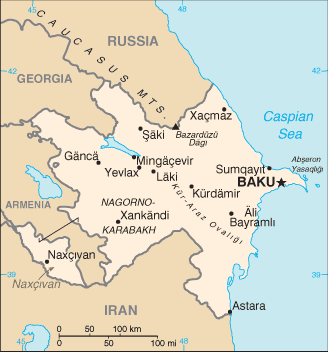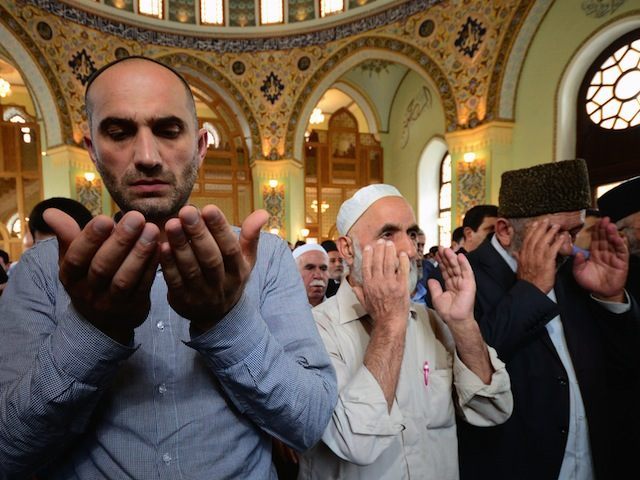This morning’s key headlines from GenerationalDynamics.com
- Azerbaijan faces rising radical Shia Islamist insurgency
- Fears that Azerbaijan’s Sunni Salafists who joined ISIS will return
- Armenia-Azerbaijan conflict in Nagorno-Karabakh surges again
Azerbaijan faces rising radical Shia Islamist insurgency

Azerbaijan, including Nagorno-Karabakh, occupied by Armenia (CIA World Fact Book)
On November 26, Azerbaijan officials killed five “radical Islamists” and arrested 32 others, all members of the radical “Movement for Muslim Unity,” in the village of Nardaran, near the capital city Baku, for allegedly plotting a coup to establish the “Sharia State of Azerbaijan.”
It sounds like a familiar story that you have read over and over since the “Arab awakening” began on 2011, but there is one big difference: The radical Islamists are Shia Muslims, and the Movement for Muslim Unity is a Shia organization.
Azerbaijan’s population is about 80% Shia Muslim, 15% Sunni Muslim and 3% Christian. The government is secular. Nardaran is an extremely poor village, and a stronghold for Shia Muslim Islamists.
On November 25, the Azerbaijani police arrested Taleh Bagirzadeh (also known as Bagirov), leader of the Movement for Muslim Unity. As many as 500 residents of Nardaran came out to the city’s main square to protest his arrest and demand his release. Clashes with the police broke out, resulting in five deaths among the demonstrators and two among the police; 14 people were arrested. The city residents then threw up barricades and demanded negotiations about those arrested and the return of the bodies of the dead. At that point, the authorities shut off power and telephone lines to Nardaran.
The charges were:
An armed radical Islamic group was preparing a series of acts of provocation, terrorist attacks and mass riots. The interior ministry has taken the necessary measures to neutralize this group… [They were] planning a forcible change of the constitutional order and the introduction of Sharia law in the country.
Jamestown and AFP and Institute for War & Peace Reporting (IWPR)
Fears that Azerbaijan’s Sunni Salafists who joined ISIS will return
Ironically, Azerbaijan also has a Sunni Islamist problem. There are communities in Azerbaijan’s north where the Salafist influence is on the rise. Although Sunnis are a small percentage of the population, it is believed that hundreds of them have been to Syria to join the so-called Islamic State (IS or ISIS or ISIL or Daesh) to fight the Shia/Alawite regime of Syria’s president Bashar al-Assad. The fear is that they will return to Azerbaijan with their newly developed terrorist skills and use it against their Azeri Shia institutions.
In recent years, developments in Azerbaijan have favored the growth of both Shia and Sunni Islamists insurgencies. Poverty is extensive. Corruption is widespread, and the gap between rich and poor is growing wider every day. The government has become increasingly oppressive, muzzling non-governmental organization representatives, independent journalists and rights activists, most of whom happen to be committed secularists.
Azerbaijan’s “rust city” of Sumgayit is a hotbed of Sunni Islamic radicals that is thought to have supplied hundreds of jihadists to ISIS. Towns in northern Azerbaijan near the border with Russia’s Dagestan, a region long troubled by Islamic militancy, also are a frequent source of Syria-bound jihadists.
Azerbaijan would be an attractive target for returning ISIS terrorists. It is one of the few countries in the world with a Shia Muslim majority population. On a geopolitical level, going after Azerbaijan would also seem attractive for the ISIS, given the country’s links to Russia, the United States and Iran, three countries that are among the ISIS’s chief antagonists. EurasiaNet (12-Aug-2015) and EurasiaNet (31-Oct-2014) and Freedom House and Guardian (London)
Armenia-Azerbaijan conflict in Nagorno-Karabakh surges again
Azerbaijan is not lacking in problems. Not only does the mostly Shia Muslim country have both Sunni and Islamist Muslim insurgencies, but also one of its provinces, Nagorno-Karabakh, is occupied by the Orthodox Christian (Armenian Apostolic) Armenians. Armenia and Azerbaijan fought a very bloody war that ended in 1994 with Armenia gaining control of Nagorno-Karabakh. Since then, hostilities between the countries have been “frozen,” but simmering. In fact, Azerbaijan is a country split into two non-connected parts, as shown in the above map. The enclave on the left is Nakhchivan, which has been the subject of past conflicts involving Turkey, Armenia and Azerbaijan.
The war that ended in 1994 has been mostly frozen since then, but hostilities have suddenly been growing.
According to Azerbaijan’s defense ministry, Armenian armed forces have broken the ceasefire with Azerbaijan 105 times in various parts of the contact line between Azerbaijani and Armenian armies over the weekend.
According to the Armenia’s defense ministry, 110 ceasefire violations by Azerbaijani armed forces were registered in the reporting period, with over 1600 shots fired from various caliber artillery weapons.
If the “frozen conflict” suddenly becomes unfrozen, as appears to be happening, then a renewed conflict would pit Armenia, Russia’s ally, against Azerbaijan, NATO-member Turkey’s ally. This would be just like the situation in Syria, where a potential war could emerge between Russia and Turkey directly. Trend (Azerbaijan) and Pan Armenian and EurasiaNet
KEYS: Generational Dynamics, Azerbaijan, Nardaran, Movement for Muslim Unity, Taleh Bagirzadeh Bagirov, Sumgayit, Islamic State / of Iraq and Syria/Sham/the Levant, IS, ISIS, ISIL, Daesh, Nagorno-Karabakh, Armenian Apostolic Church, Nakhchivan, Turkey
Permanent web link to this article
Receive daily World View columns by e-mail

COMMENTS
Please let us know if you're having issues with commenting.